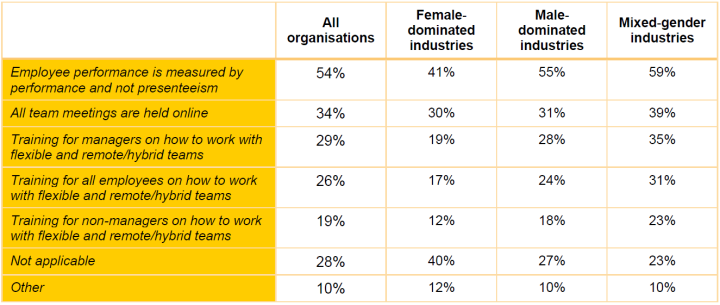Australian employers are choosing to move to an ‘all roles flex’ model for employees, allowing their staff to determine how, where and when they work.
New data on flexible work, reported by employers to the Workplace Gender Equality Agency (WGEA) has been released today.
A new voluntary question in the WGEA’s 2021-22 Employer Census asked whether employers had implemented an ‘all roles flex’ approach to flexible work, with a response provided by 78% of the nearly 5,000 reporting employers.
Of those, 38% have implemented an ‘all-roles flex’ approach, ensuring the focus is on work output and outcomes – not hours spent in the office.
However, the rates of ‘all roles flex’ offered varied significantly across industry types, with 48% of mixed-gender industry employers offering this flexibility, compared to 30% of male and female-dominated industries.
Male and female-dominated industries are more likely to require a physical presence in the performance of duties, such as nursing, disability care, construction, mining and farming, which may offer an explanation on their comparatively slow uptake.
‘All roles flex’ is among the priority actions that researchers in Australia and internationally say can drive progress towards gender equality.
Further, nearly two-thirds of respondents (62%) said they were more likely to approve formal flexible working arrangements for both women and men because of COVID.
The rise of remote working
When the Census digs into formal actions employers are taking to support employees, not surprisingly, it confirms a sharp rise in telecommuting, or working from home, since 2019.
In 2022, 71% of employers report having a formal policy working from home. This increased from 35% in 2019 (pre-COVID levels) to 66% in 2021.
Other forms of flexible work showed smaller year-on-year increases in availability, including job-sharing (at 52% in 2022, up from 49% last year), flexible hours of work (74% in 2022, from 70% in 2021) and a compressed working week (at 42%, up from 40% from last year).
WGEA Director Mary Wooldridge said employers need to look beyond working from home when thinking about flexibility in the workplace.
“Flexible work is a key driver for gender equality, but employers should be creative to enable their employees to have flexibility that meets their specific needs,” Ms Wooldridge said.
“Innovative actions we’ve seen from employers include creating shifts specifically within or outside of school hours and offering job sharing or part-time work arrangements for managerial or executive roles. These types of measures make it easier for men and women to equally participate in the workforce – whether that’s from the office or home.”
Employees want to work flexibly
Research shows that nine in 10 employees are looking for flexibility[1].
There’s broad benefits of employer action to embrace flexible work, with evidence to show improved outcomes on employee retention and performance and a more tailored employee experience.
In contrast, a third of Australian employees who are working flexibly report they would immediately quit their job or start looking for a new one if they were required to return to the office full time[2].
At a time when unemployment is at record lows and employers are struggling to fill vital roles, recent research found that advertising flexible working options led to a 20% to 30% increase in applicant pools[3]. Further, advertising new roles or promotions as open to part-time or job-sharing resulted in increased applications from women to senior leadership roles.
What can employers to do boost flexiblility?
But Ms Wooldridge said employers must be mindful in their approach to flexible work.
Recent research[4] has also suggested a varied experience with hybrid working during the pandemic, including negatives like longer working hours, reduced exposure to executive leadership, impacts on a chance of promotion or exclusion from important meetings.
“COVID has undoubtedly changed how we think about remote working, and while that is a big shift, it risks creating a two-tiered system – one for employees returning to workplaces and another for those who are not – if it is not implemented well,” Ms Wooldridge said.
Actions employers can take on flexible work include:
- Implementing an ‘all roles flex’ policy for all employees, regardless of gender, age, caring responsibilities, or their level in the organisation.
- Trusting your people by driving a culture of performance, not presenteeism.
- Leading from the top with managers and leadership teams encouraged to role-model flexible work arrangements.
- Communicating effectively with remote workers, including with the use of collaborative management software, by conducting meetings for hybrid or remote teams online or more regular written or audio-visual updates on tasks.
- Acknowledging the adjustment to a new way of working and allowing the individual and team time to adjust.
- Setting clear boundaries and expectations on work hours and email communication for remote employees.
NEW VOLUNTARY QUESTION: Measures to ensure the fair treatment of all employees regardless of work location
The new data insights come as part of WGEA’s 2021-22 Employer Census on gender equality of employers of 100 or more employees.
The full 2021-22 Gender Equity Scorecard will be published by the Agency in early December.
WGEA media contact
Emma Manser
WGEA Media & Communications Manager
We collect, analyse and publish world-leading data on workplace gender equality covering more than 4 million employees in Australia.
Gender equality is good for business. Find tools and guides for conducting a pay gap analysis, implementing flexible work and creating a gender strategy.
WGEA is a federal government agency created by legislation to promote and improve gender equality in Australian workplaces. Find out more about our work.

